Featured Comment
Flavorful pickled cucumber dish – sweet, spicy and a touch of nuttiness. I’ve made the recipe twice this week as it gets eaten up very quickly and will be working on my third batch shortly.
★★★★★
– Christine
What if your weeknight table felt like a Japanese izakaya? Cool cucumber and my simple technique make that possible! No plane ticket required.
From kappa maki to sunomono and tataki kyuri, cucumbers are beloved in Japan. A touch of ginger and chili makes these cucumber tsukemono unforgettable.
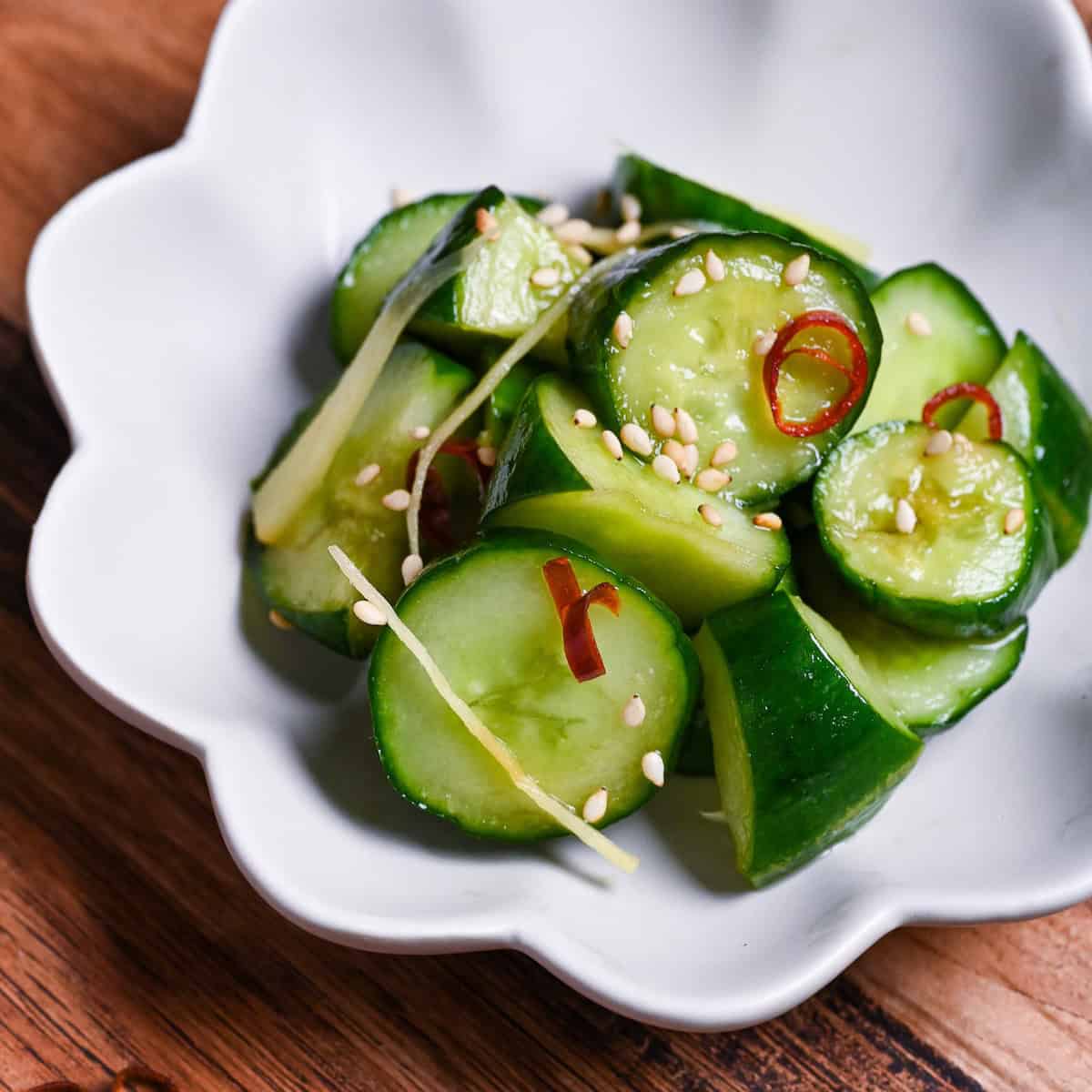
Cucumber Tsukemono
Recipe Snapshot
- What is it? Quick Japanese cucumber pickles (tsukemono).
- Flavor profile: Crisp, Tangy, Sweet-savory
- Why you’ll love this recipe: It takes just one hour to marinate and requires zero cooking, perfect for busy weeknight schedules.
- Must-haves: Cucumbers, Fresh ginger, Salt
- Skill Level: Easy
- Suitable for Meal Prep? Yes!
Summarize & Save this content on:
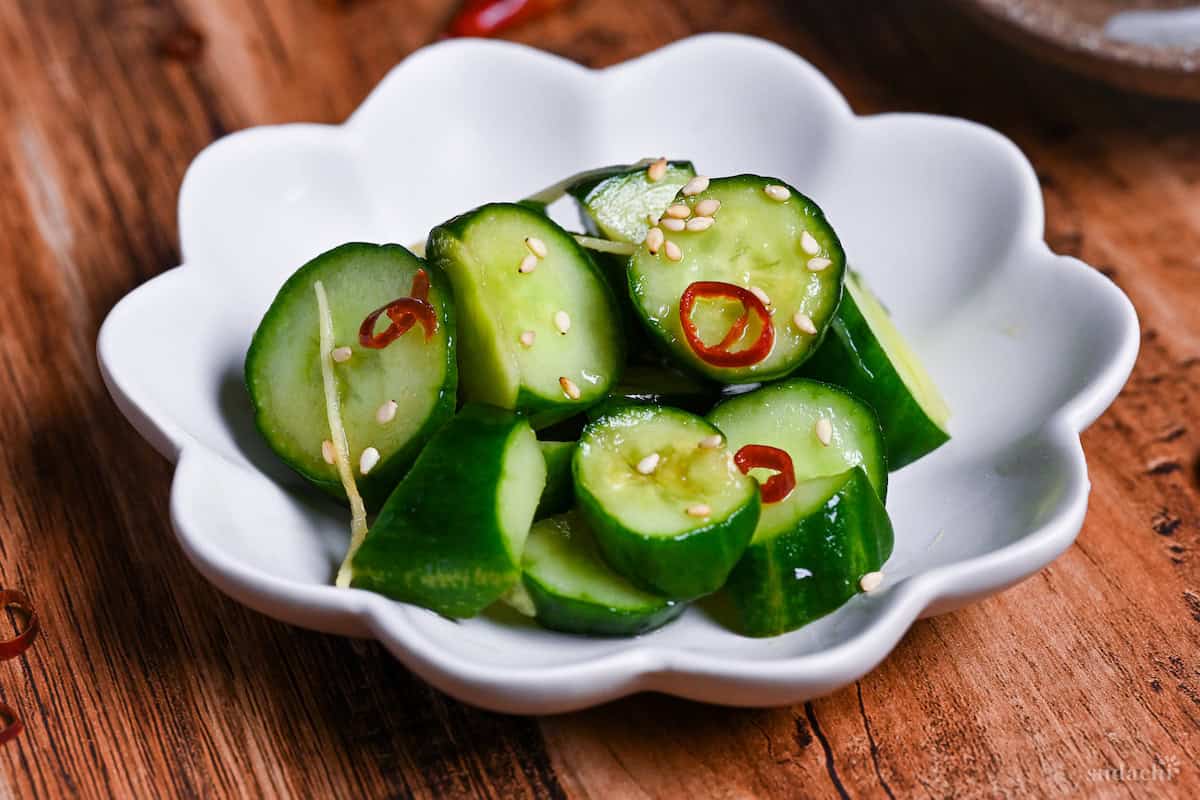
What is Tsukemono (Japanese Pickles)?
Tsukemono (漬物), or Japanese pickles, are a colorful part of everyday meals in Japan. They’re made by preserving vegetables in salt, soy sauce, miso, vinegar, or rice bran, with flavors ranging from sharp and tangy to mellow and sweet.
Some are long-fermented, like umeboshi (pickled plums) and takuan (pickled daikon), while others are sweet accompaniments such as fukujinzuke, often served with Japanese curry. For a spicier kick, you’ll find wasabi pickles, while celebratory dishes like namasu bring a refreshing vinegar brightness. Even the familiar sushi ginger is part of the tsukemono family.
At home, one of the easiest ways to enjoy this tradition is with quick asazuke (浅漬け) recipes like this Japanese cucumber pickles. They’re fast, crisp, and perfect for balancing a weeknight meal.
Cucumber Tsukemono Ingredients
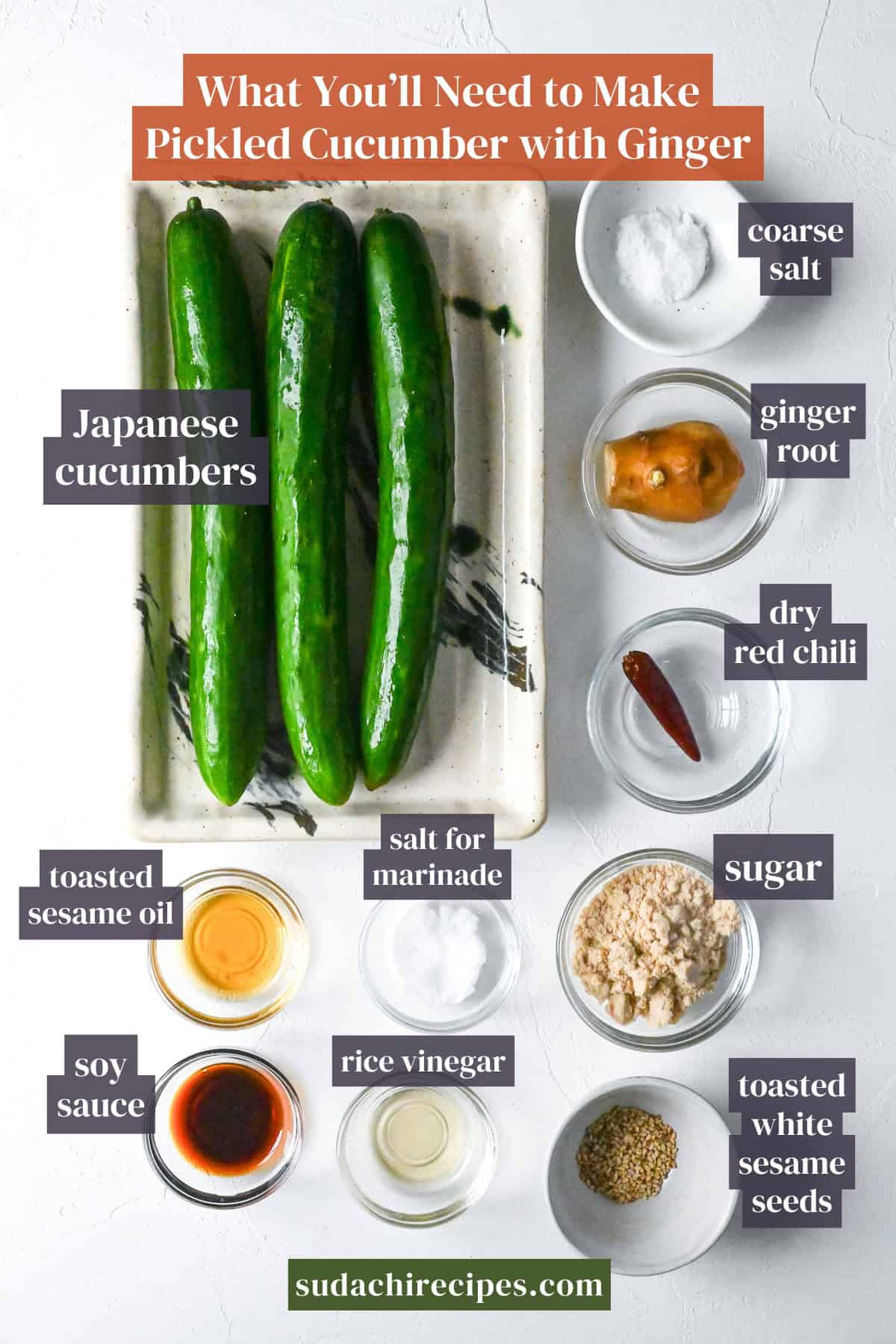
- Japanese or Persian cucumber: You’ll find them at Asian grocery stores. Persian/mini cucumbers are common at regular supermarkets, and Japanese cucumbers are also sold by online Asian grocers.
- Salt: This is the quick brine that pulls out excess water so the cucumber tastes concentrated and crisp, not soggy. Grab coarse sea salt or kosher salt. Table salt is not recommended for this recipe.
- Ginger root: Fresh ginger adds citrusy, peppery warmth that wakes up cool cucumber and leaves a fragrant finish.
Substitution Ideas
- Japanese cucumber: Persian (mini) cucumbers or Kirby cucumbers work perfectly. If you’re stuck with regular English cucumbers, peel strips of the waxy skin off with a vegetable peeler and scoop out the large, watery seeds with a spoon. The extra prep is worth it to avoid a soggy result.
- Dried red chili: Any small dried red pepper will do the trick. Italian peperoncino, Thai chilies, or even the ones from your local grocery store’s spice aisle. Start with half if you’re unsure about heat level, or substitute red pepper flakes if that’s what you have on hand.
- Rice vinegar: Apple cider vinegar works in a pinch, but use about 25% less since it’s more acidic. White wine vinegar is another backup option.
Have trouble finding Japanese ingredients? Check out my ultimate guide to Japanese ingredient substitutes!
How to Make My Japanese Cucumber Pickles
If you prefer to watch the process in action, check out my YouTube video of this cucumber tsukemono recipe!
i. Peel a thumb-size knob of fresh ginger and cut it into fine matchsticks.
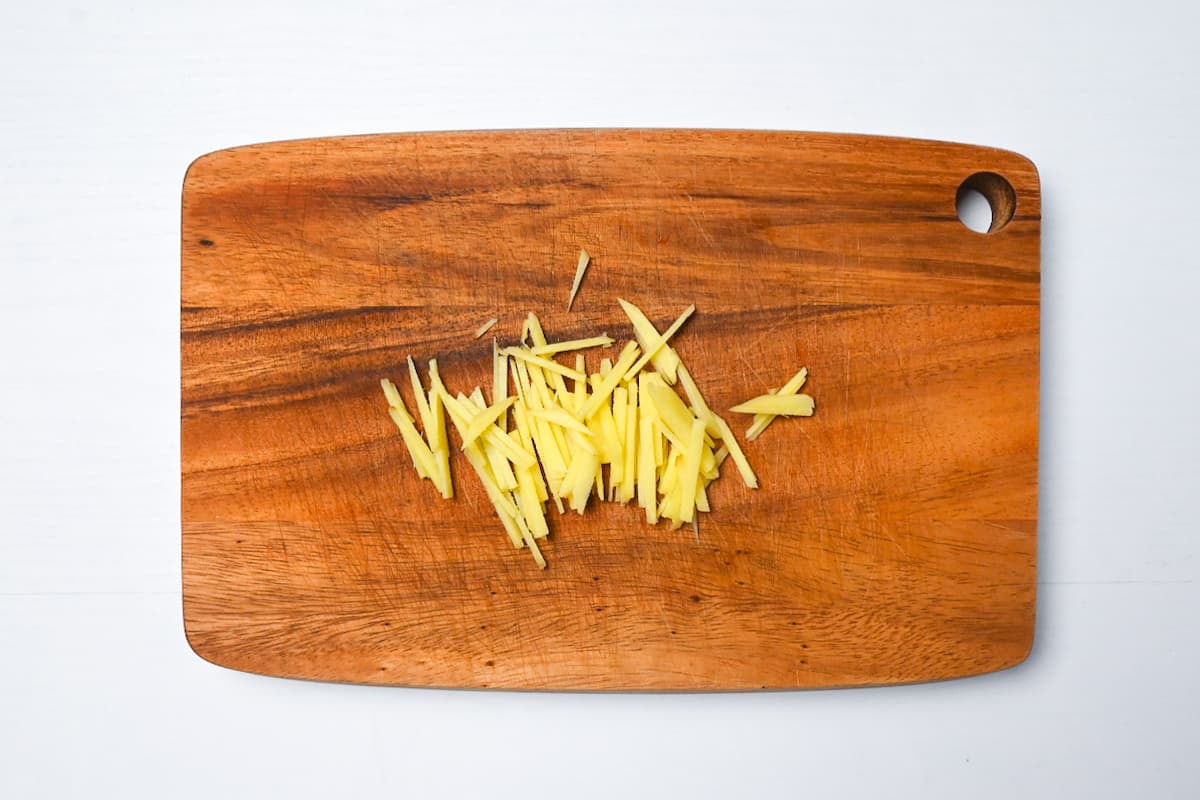
ii. Thinly slice 1 dried red chili (or use ½ tsp red pepper flakes). These aromatics infuse the brine with warmth and freshness so the cucumbers don’t taste flat.
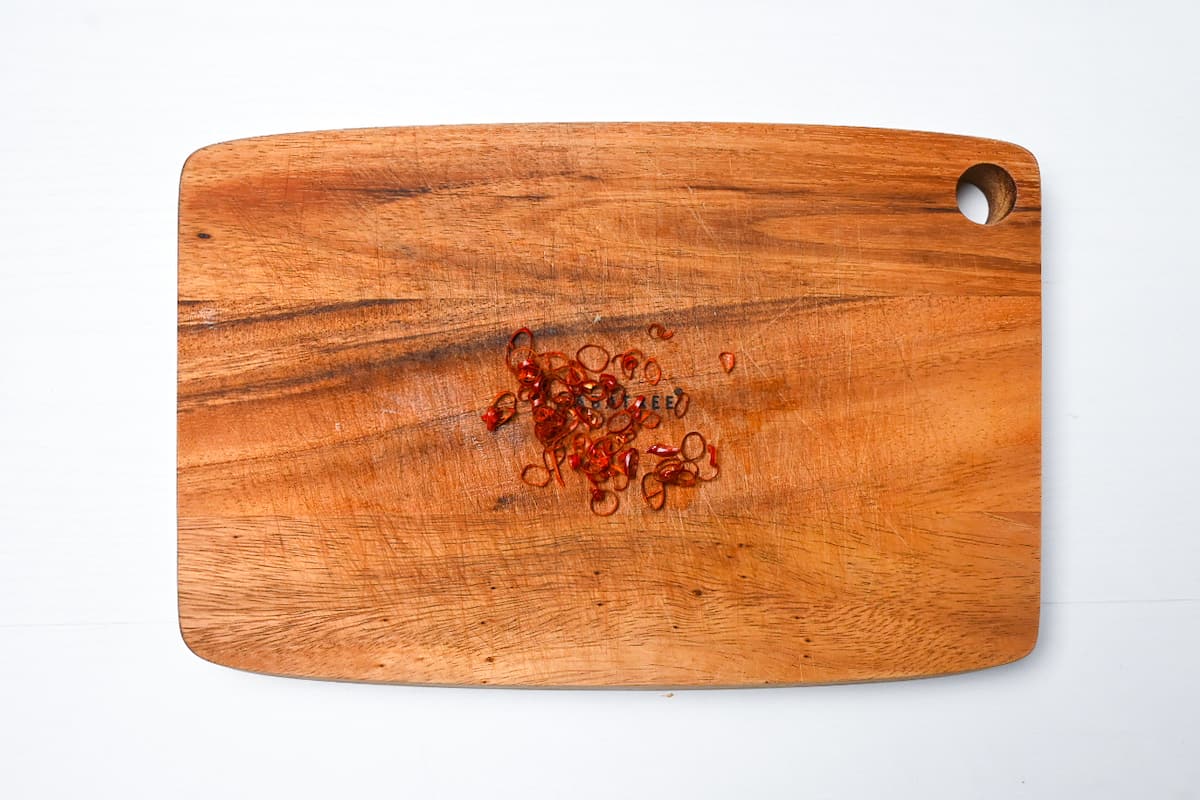
Removing the chili’s seeds and inner pith dials back sharp heat while keeping color and aroma. Ginger’s freshness balances the briny-sweet marinade so the salad stays lively, not heavy.
i. Wash your cucumbers, sprinkle kosher or sea salt over a cutting board, and roll each cucumber firmly under your palms to rub in the salt.
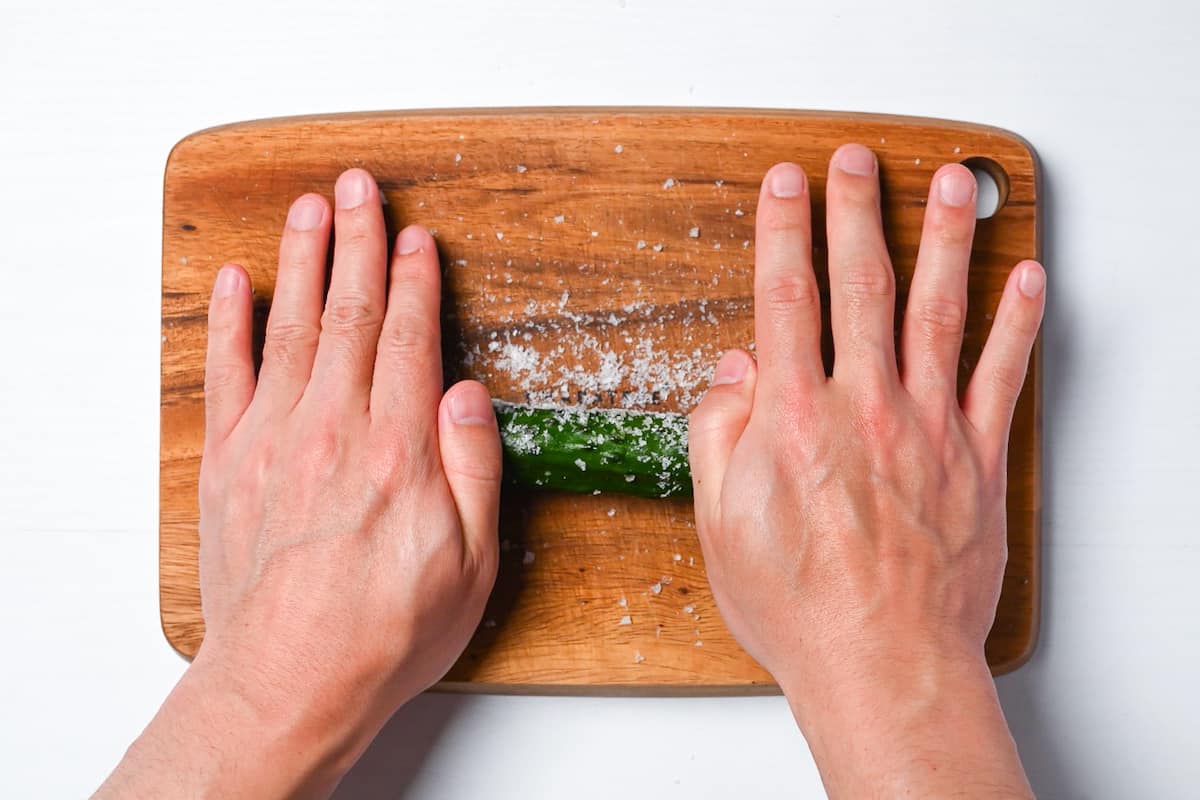
This quick technique is itazuri. If your cucumbers are very slender (Persian/Japanese), lighten the pressure to avoid breaking them.
Salt scrubs away tiny spines and gently abrades the skin so flavors soak in. It also starts drawing out excess moisture so the final texture stays snappy.
ii. Rinse the cucumbers briefly to remove excess surface salt, then pat them dry until they feel just damp, not wet.
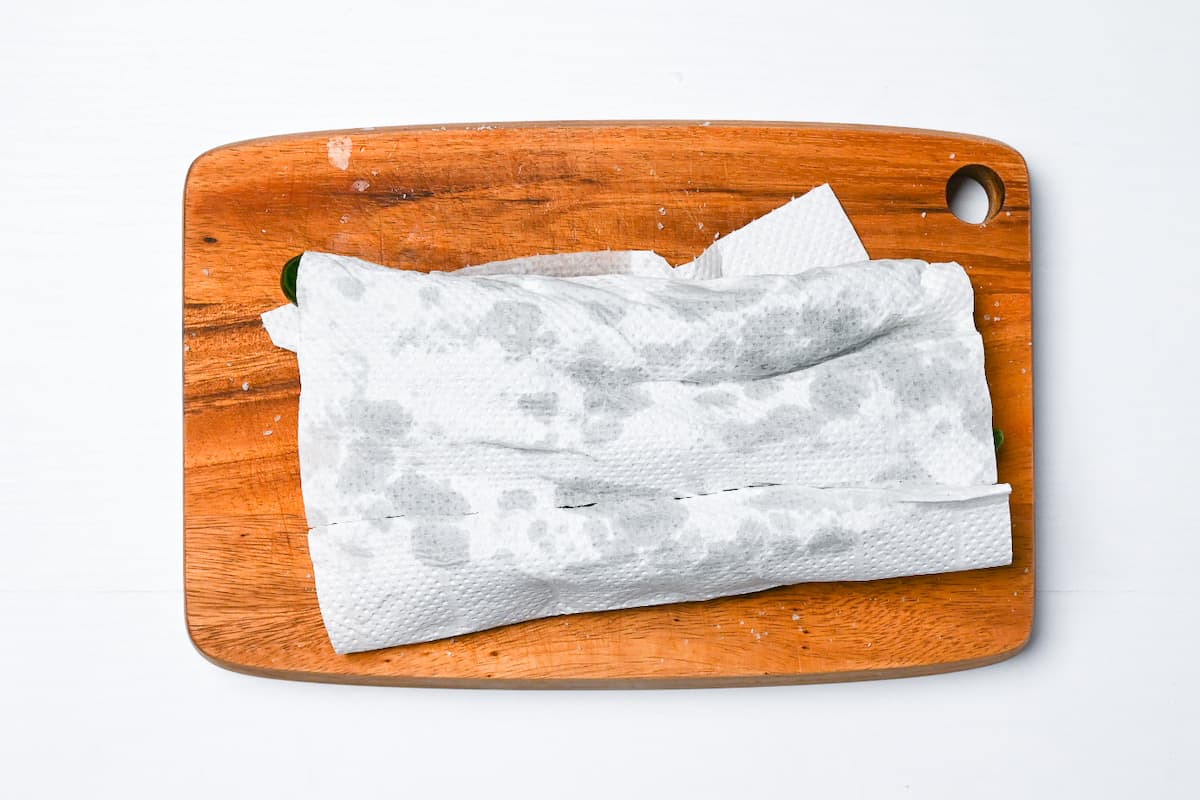
Drying keeps the brine from diluting and helps the dressing cling. If using large American slicing cucumbers, halve lengthwise and scoop the watery seed core. English/Persian types usually keep their seeds.
iii. Lay a cucumber and tap it with a sturdy glass or rolling pin just until it cracks lengthwise in a few places.
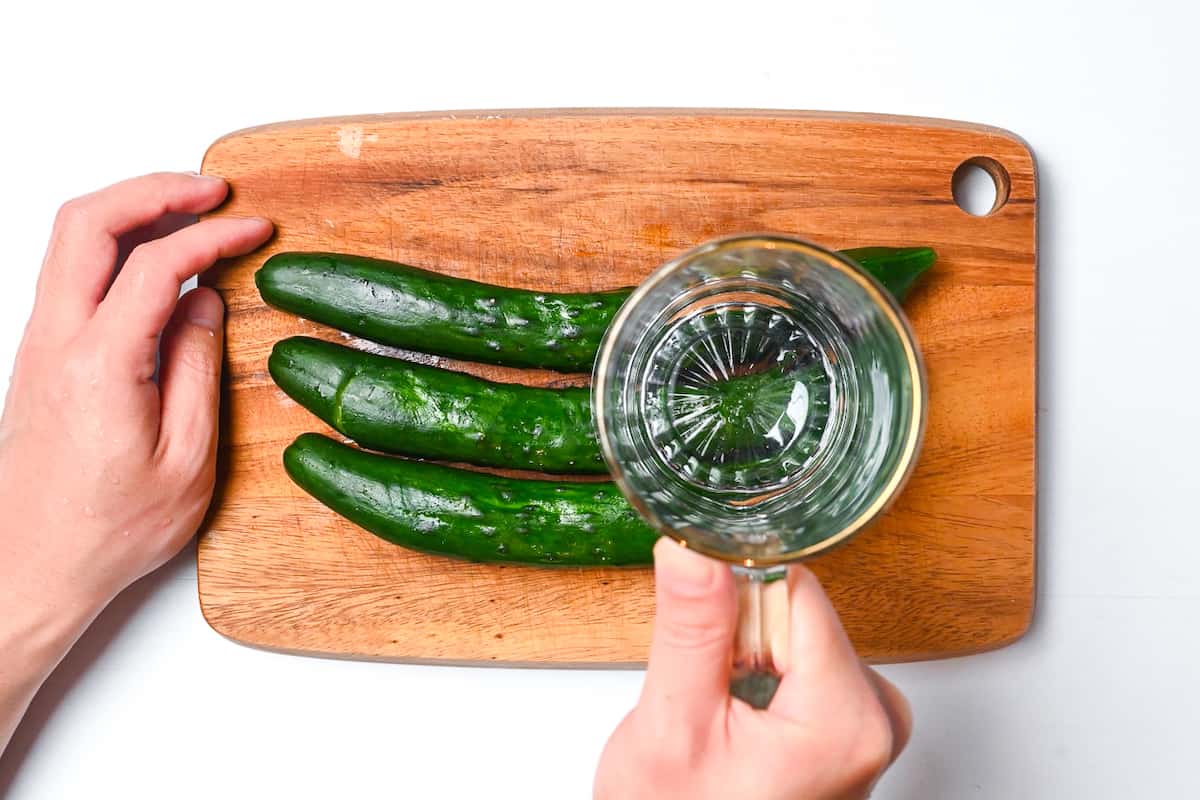
iv. Then cut into bite-size chunks. Those jagged edges act like flavor sponges, giving you dramatic absorption without turning the flesh mushy. Listen for gentle cracks and stop while the pieces still feel firm.
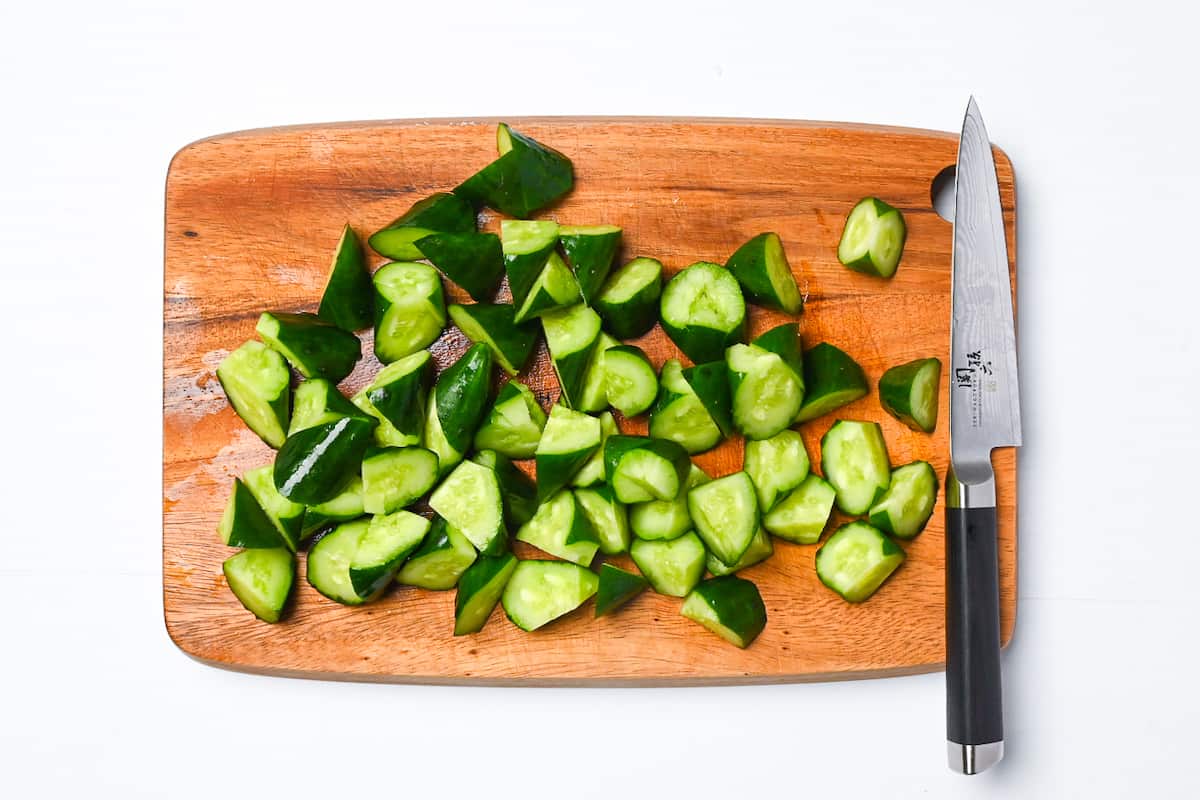
i. Tumble the cucumber chunks into a zipper bag with the ginger and chili, then add sea salt, sugar, rice vinegar, Japanese soy sauce, and toasted sesame oil. Press out most of the air and seal.
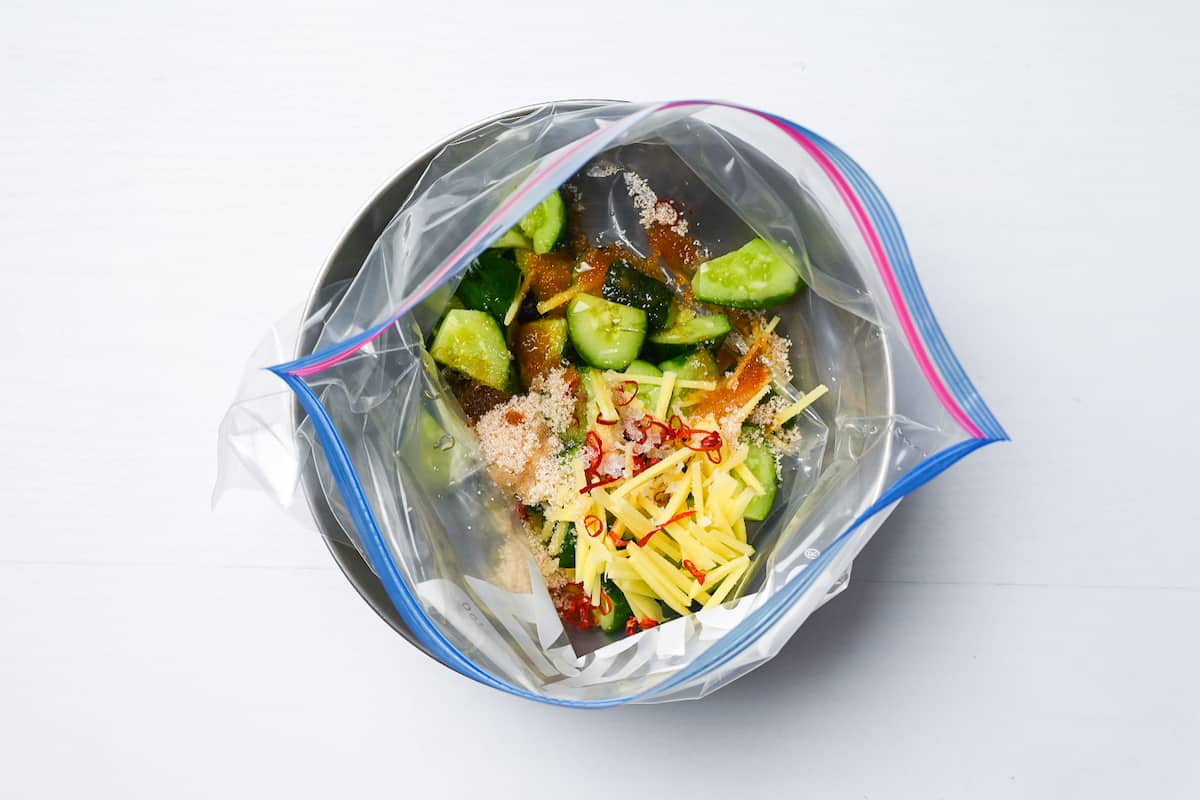
Soy brings savory base notes, rice vinegar adds lift, sesame oil supplies nutty aroma, and sugar balances the salinity so the cucumbers taste crisp, not harsh.
Slip in a 5-cm square of dried kombu and let its natural glutamate dissolve into the brine for savory depth without extra salt. It’s a classic Japanese trick that adds “dashi-like” roundness to quick pickles.
ii. From the outside of the bag, gently massage for 30-60 seconds so seasonings distribute and the cucumber edges soak up flavor. You’re aiming for slick, evenly glazed pieces with a few teaspoons of brine pooling at the bottom.
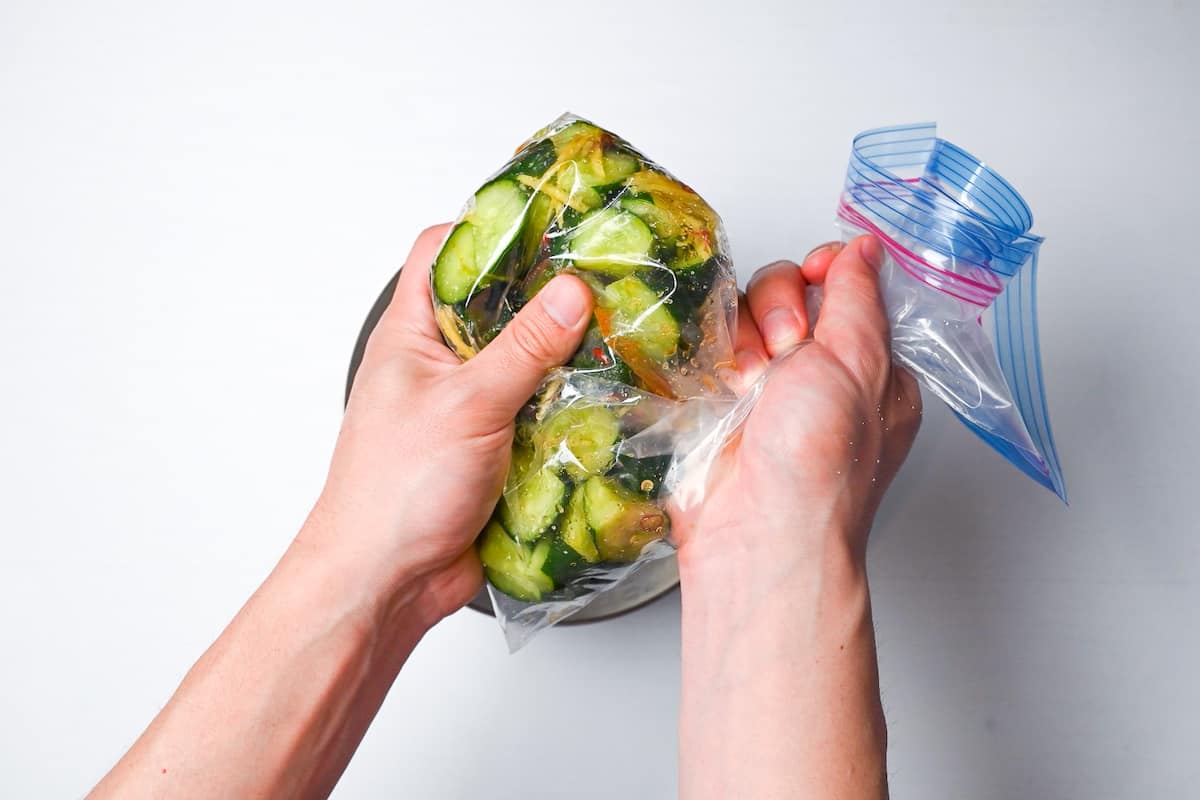
If sugar is slow to dissolve, rest the sealed bag at room temp for 2-3 minutes, then massage again. Avoid heavy squeezing here. The smash already did the tenderizing.
i. Flatten the sealed bag so the cucumbers lie in a single layer, set it on a small tray, and lay another tray or plate on top with a light weight (a water-filled bottle also works).
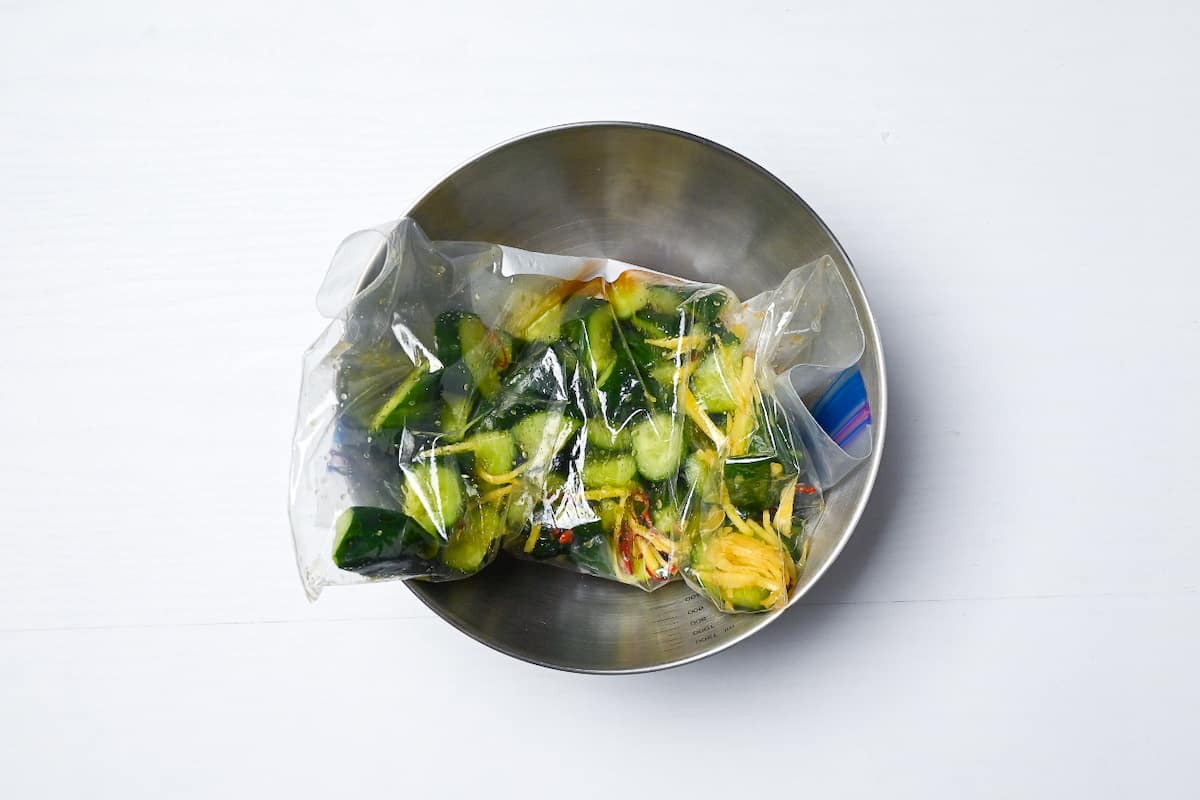
ii. Chill at 4℃ (39°F) for at least 1 hour, overnight deepens flavor and draws more water into the brine.
For quick pickles like this, a light weight is enough to coax moisture out and reduce “pockets” of unseasoned cucumber. If your cucumbers are very delicate, skip the weight and extend the chill by 30-60 minutes.
i. Drain lightly and sprinkle with a little toasted white sesame for nutty aroma, then serve chilled. You’re looking for crisp edges, a juicy snap, and a sweet-salty-tangy finish.
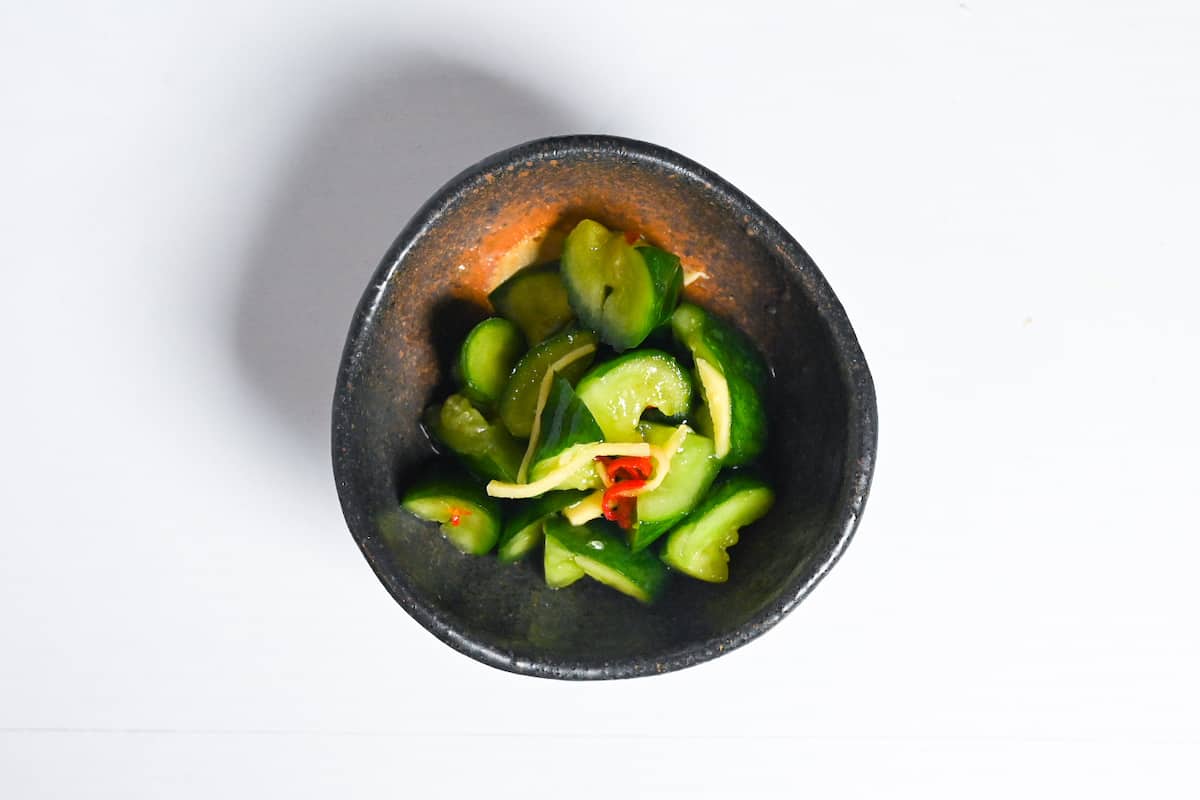
Best texture is within 24-48 hours.

Variations
- Spicy Heat: Double the dried chili or add a pinch of red pepper flakes for more kick. The longer you marinate with the spice, the deeper the heat will penetrate.
- Citrus Fresh: Add thin strips of yuzu, lemon or lime zest during marinating for a bright, restaurant-like twist.
- Garlic Lovers: After the basic pickle is ready, toss with a quick sauce of minced garlic.
- Western-Inspired: Swap the soy sauce for a bit more rice vinegar and add fresh dill or a bay leaf. You’ll get something that bridges the gap between Asian pickles and the dill pickles.
Start with small amounts of any add-ins since you can’t take them back once they’re in.
Storage & Meal Prep
Fridge: Airtight container, 1-2 days.
Fridge: Store the cucumbers with their pickling liquid in an airtight container or a sealed bag, making sure the pieces stay submerged. They taste best the same day or next, but you can enjoy them up to 2-3 days. By day 5 the crunch and bright color fade noticeably.
Freezer: Not suitable.
Meal Prep: You can prepare the whole dish the night before, then let them marinate in the fridge to serve the next day with dinner.
What to Serve With This Recipe
Cucumber Tsukemono Q&A
No. At room temperature, cucumbers spoil quickly, especially in summer even if they look fine. Always marinate in the refrigerator, and use clean utensils and containers.
Strong flavors like chili, ginger, or garlic can easily overpower the cucumber. Always start small and taste as you go. If you’ve overdone it, remove the extra aromatics from the brine. With asazuke, simplicity works best.
Serve slightly chilled, not ice-cold, so the savory-sweet notes are easier to taste. Drain off excess liquid before plating to keep the presentation clean.
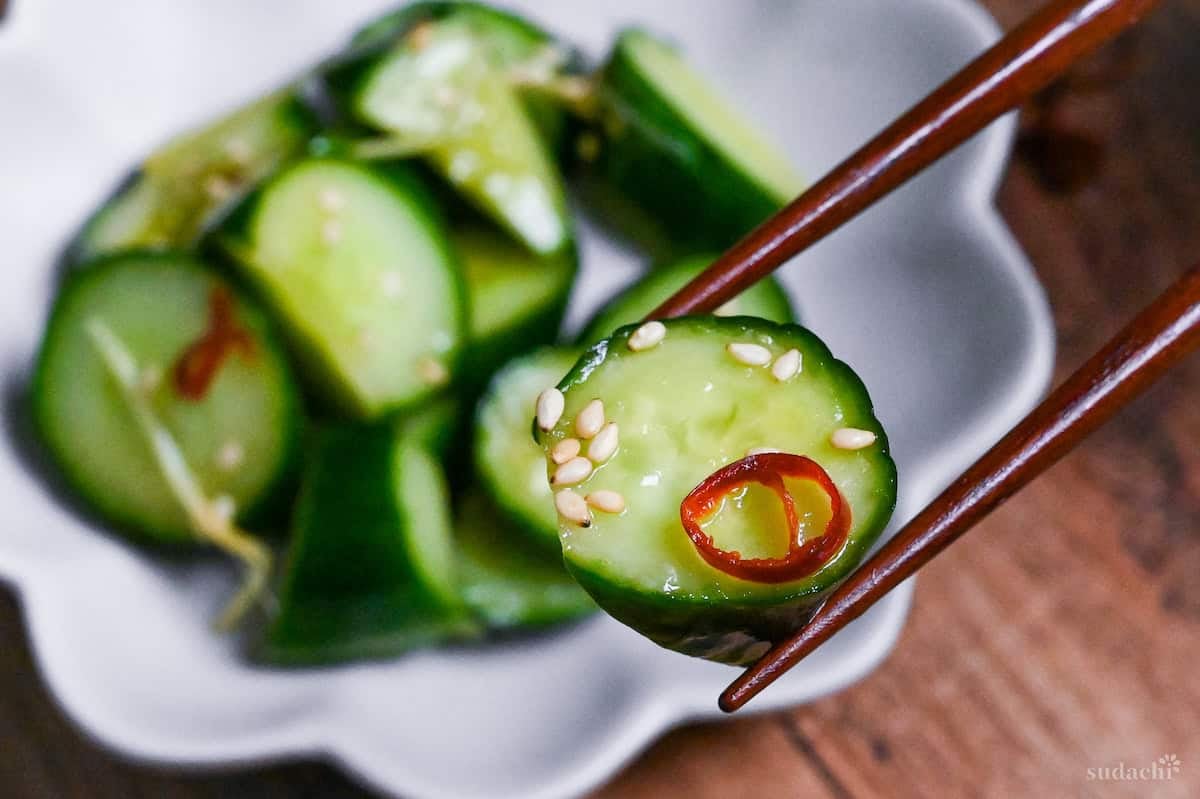
More Weeknight Japanese Recipes
Looking for more inspiration? Browse through these easy Japanese weeknight meals that will transform your dinner routine!
Did You Try This Recipe?
I would love to hear your thoughts!
💬 Leave a review and ⭐️ rating in the comments below. 📷 I also love to see your photos – submit them here!
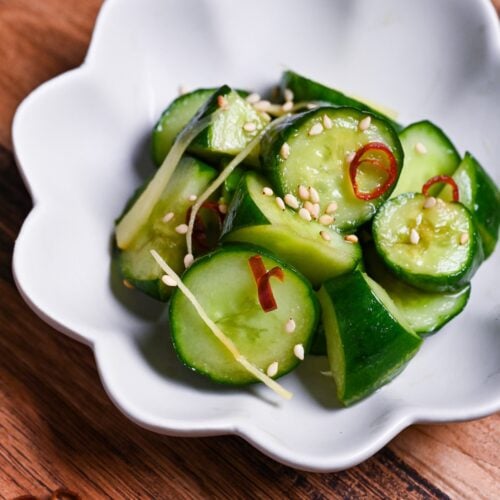
Cucumber Tsukemono with Ginger (Japanese Pickled Cucumber)
Ingredients
- 20 g ginger root approx 3cm, a little over 1 inch
- 1 dried red chili pepper deseeded
- 300 g Japanese cucumber or Persian cucumber (if using English cucumber, cut in half lengthways and scrape out the seeds first)
- 1 tsp salt coarse type to scratch the skin
- 1 tsp sea salt
- 2 tbsp sugar white or light cane
- 1 tsp rice vinegar unseasoned
- 1 tsp Japanese soy sauce (koikuchi shoyu) tamari works for GF
- 1 tsp toasted sesame oil don’t substitute with neutral oil
- 1 pinch toasted white sesame seeds optional garnish
My recommended brands of ingredients and seasonings can be found in my Japanese pantry guide.
Can’t find certain Japanese ingredients? See my substitution guide here.
Instructions
- First, peel the skin off 20 g ginger root and cut it into thin strips (julienne).

- Cut 1 dried red chili pepper into thin slices.

- Wash 300 g Japanese cucumber and sprinkle a chopping board with 1 tsp salt. Roll each cucumber in the salt.

- Wash off the salt and dry the cucumber. (If you're using English cucumber, cut it in half lengthways and scoop out the seeds with a spoon.)

- Smash the cucumber with something sturdy like a heavy glass cup or rolling pin. Crush/break it slightly, but not too much.

- Roughly cut the cucumber into bitesize pieces.

- Place the cucumber in a sealable bag with the ginger and chili, then add the 1 tsp sea salt, 2 tbsp sugar, 1 tsp rice vinegar, 1 tsp Japanese soy sauce (koikuchi shoyu) and 1 tsp toasted sesame oil.

- Massage the ingredients into the cucumber to evenly distribute them.

- Marinate in the refrigerator for at least one hour. (For best results, overnight.)

- Sprinkle with 1 pinch toasted white sesame seeds upon serving and enjoy!

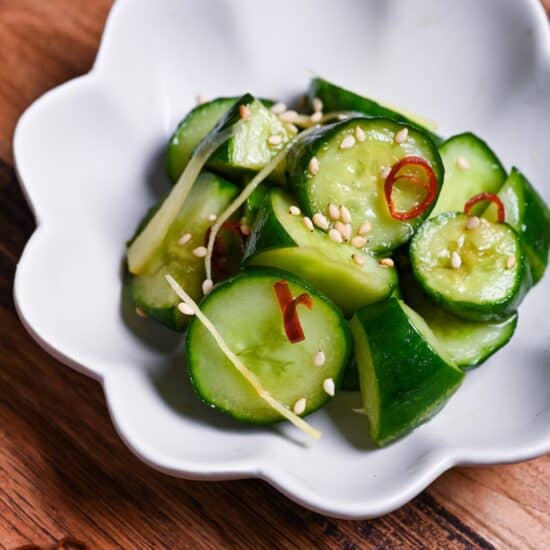




Can you can these cucumbers and keep them on the self for up to a year like regular pickles?
Hi Karen,
These pickles are a type of asazuke (quick/light pickles) and are best eaten within about 3 days, maximum a week. They should also be refrigerated and don’t last well at room temperature. Hope that helps!
Flavorful pickled cucumber dish – sweet, spicy and a touch of nuttiness. I used sugar substitute for a diabetic and it tasted great. First time using a rolling pin on cucumbers, which worked great to soften them. I’ve made the recipe twice this week as it gets eaten up very quickly and will be working on my third batch shortly.
Hi Christine,
Thank you for the comment! I’m so happy that you’ve already made this recipe multiple times! 🙂
Yuto
made this! and it’s yum! even tho i omitted/subs some ingredients as these were unavailable in my pantry… i used cane vinegar for tice vinegar & change the sugar-vinegar ratio. i omitted the sesame oil & sesame seeds. i don’t know koikuchi shoyu, i used Kikkoman that is 43% less salt. i used chili flakes instead of dried chili pepper. i mixed salt, sugar, vinegar & soy sauce in a separate bowl (to do a taste test) before adding it to the cucumber mix in a zip lock bag. this turned out very good, too! will definitely do this again with the right ingredients! thank you for sharing this recipe!
Hi Ad Pi,
Thank you for giving this a go! Love how you made it work with what you had! Really happy to hear it still turned out delicious
Yuto